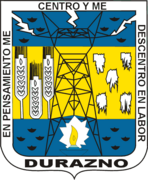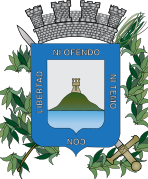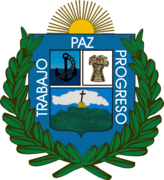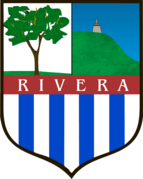Uruguayan coat of arms
The State Coat of Arms or simply National Coat of Arms of Uruguay is one of the country's national symbols. It was approved by the laws of March 19, 1829 and July 12, 1906 and the decree of October 26, 1908. In accordance with this last decree, the official model of the National Shield was established, the one presented by Mr. Miguel Copetti.
Legal Description
The State Shield shall always be constructed and represented in the following manner:
- An oval divided into four barracks and crowned by a sun.
- A balance as a symbol of equality and justice, placed on blue enamel at the top of the left.
- At the top of the right the Cerro de Montevideo, as a symbol of strength, in silver field.
- At the bottom of the left a loose horse as a symbol of freedom in the silver field.
- At the bottom of the right, on blue glaze, an ox, as a symbol of abundance.
- This oval will be pegged by two branches, one of olive trees and another of laurel joined at the base by a loop, blue.
THE OVALO: It will be built with four arches and four centers. It will be divided into four barracks, taking as axis the longitudinal and transversal part, and diagonally altering with two colors or backgrounds: the glaze blue and the silver (metal) remaining from the first the two barracks, the top of the right and the bottom of the left; and the second, the top of the left and the bottom of the right. (The left of the observer is considered a right part of the oval.)
THE SOL: that crowns the oval will be configured with its three fourth visible parts, drawing the disc with a face, having to see the eyes and nose only; from that disc will come seven rays in the form of a spearhead; from among them there will be six other rays drawn in such a way as flames of fire; the disc and the rays referred will be made with sharp or polished gold.
THE BALANZA: It will be configured of an ancient Roman type and will be painted with sharp gold.
THE MONTEVIDE CER: It will be painted by imitating it of the natural, as well as the fortress that crowns it, trying to configure it with the proportions that are observed in the model types or in the official pattern; at the foot of the Cerro, the water will be set heraldically, that is, by means of five blue and undulating stripes, alternated among themselves by the silver background.
THE CABALLO: It will be painted black and in motion, indicating to be loose and free.
THE BUEY: It will be painted in gold, with its outlines and natural shadows. These two symbols (horse and ox) should not have a floor, as if it were their support.
The branches of the laurel and olive trees shall orient to the ovalo, placing the first on the left and the second on the right; it will try to imitate as much as possible those branches and leaves to the natural ones.
INSCRIPTIONS: That he should wear the shield will always be painted of gold or imitation of it, being forbidden to use another color.Decree of 26 October 1908.
Modification
In accordance with the modification indicated by the Executive Power in 1908, the military and navy trophies that adorned the shield were suppressed, leaving it bordered by two branches, one olive and the other laurel united at the base by a light blue ribbon.
Historical shields
Departmental shields
Other proposals for the Coat of Arms
One of the first mentions of a coat of arms that would represent the new republic is found in one of the proposals for the first constitution of the future Eastern State of Uruguay, where the following provision drafted in 1828 by Manuel Errázquin regarding the national emblem:
"The weapons of the state will be a shield bent of laurels with a rising sun; in the middle, at the top a sword on whose tip will rest a balance and in the faithful of this an incarnated hat, and at the bottom a horse suffering on a plain"
The National Historical Museum houses another project for a national emblem proposed by Ramón Massini, although it never came to the consideration of the General Assembly. It is described as:
"do it divided into four barracks and in the center, a second oval with two barracks. In the upper left quarter, on the blue field of prussia, a flag formed by two white stripes and a red one placed in the center, diagonally: on the right side, on the battalion field, the figure 33. in white, at the lower left barracks, a flag formed by two blue stripes and a white one, in the center, in which there is a red sun; on the right, on the green sea field, two crossed alfanjes. In the central oval, at the top quarter, a tower, in a cobalt blue field; at the bottom, a hill"
Contenido relacionado
Maracanazo
Gunther von Hagens
Elizabeth I



























